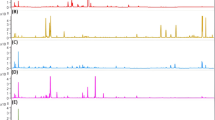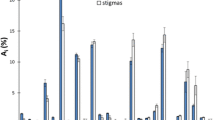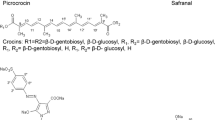Abstract
Gas chromatography with mass spectrometry detection (GC-MS) coupled with headspace-solid-phase microextraction (HS-SPME) was used to analyse the aroma profile of genuine saffron (Crocus sativus L.) and samples of this spice artificially adulterated with Calendula officinalis L. petals (calendula), Carthamus tinctorius L. petals (safflower) and Curcuma longa L. powdered rhizomes (turmeric). Preliminary analyses of genuine saffron and pure contaminants were performed to select the kind of SPME sorbent. Moreover, an experimental design combined with response surface methodology was applied to optimise the sample temperature and the fibre exposure time with the aim of enhancing the detection of the above adulterants in counterfeited saffron samples. The GC-MS chromatograms collected under the optimised conditions were finally handled by unsupervised and supervised multivariate statistical methods to differentiate the genuine saffron samples produced in three different Italian regions from artificially adulterated samples at 2–5% w/w contamination levels. Thirty genuine and 30 counterfeited (10 for each kind of adulterant) saffron samples were analysed. Principal component analysis was applied to assist the choice of the GC/MS data pre-treatment and classification of genuine and adulterated saffron samples was attempted by partial least square-discriminant analysis (PLS-DA). Predictive performance of PLS-DA models calibrated with 42 samples was finally tested on 18 saffron samples (9 genuine and 9 adulterated). All the external saffron samples were correctly classified regardless of the kind of contaminant, while in calibration, only a saffron sample contaminated with safflower was erroneously assigned to the group of genuine ones. Class modelling of genuine saffron performed by SIMCA (Soft Independent Model Class Analogy) exhibited a good sensitivity and 100% specificity for external adulterated samples.







Similar content being viewed by others
References
Alonso GL, Salinas MR, Garijo J (2016) Method to determine the authenticity of aroma of saffron (Crocus sativus L.). J Food Prot 61:1525–1528. https://doi.org/10.4315/0362-028x-61.11.1525
Ballabio D, Consonni V (2013) Classification tools in chemistry. Part 1: linear models. PLS-DA. Anal Methods 5:3790–3798. https://doi.org/10.1039/c3ay40582f
Bezerra MA, Santelli RE, Oliveira EP, Villar LS, Escaleira LA (2008) Response surface methodology (RSM) as a tool for optimization in analytical chemistry. Talanta 76:965–977. https://doi.org/10.1016/j.talanta.2008.05.019
Binder RG, Benson ME, Flath RA (1990) Volatile components of safflower. J Agric Food Chem 38:1245–1248. https://doi.org/10.1021/jf00095a020
Bosmali I, Ordoudi SA, Tsimidou MZ, Madesis P (2017) Greek PDO saffron authentication studies using species specific molecular markers. Food Res Int 100:899–907. https://doi.org/10.1016/j.foodres.2017.08.001
Brereton RG, Lloyd GR (2014) Partial least squares discriminant analysis: taking the magic away. J Chemom 28:213–225. https://doi.org/10.1002/cem.2609
Chandran S, Singh RSP (2007) Comparison of various international guidelines for analytical method validation. Pharmazie 62:4–14. https://doi.org/10.1691/ph.2007.1.5064
Cocchi M, Biancolillo A, Marini F (2018) Chemometric methods for classification and feature selection. In: Jaumot J, Bedia C, Tauler R (eds) Data analysis for omic sciences: methods and applications, comprehensive analytical chemistry, vol 82. Elsevier, Amsterdam, pp 265–299
D’Archivio AA, Maggi MA (2017) Geographical identification of saffron (Crocus sativus L.) by linear discriminant analysis applied to the UV–visible spectra of aqueous extracts. Food Chem 219:408–413. https://doi.org/10.1016/j.foodchem.2016.09.169
D’Archivio AA, Giannitto A, Maggi MA, Ruggieri F (2016) Geographical classification of Italian saffron (Crocus sativus L.) based on chemical constituents determined by high-performance liquid-chromatography and by using linear discriminant analysis. Food Chem 212:110–116. https://doi.org/10.1016/j.foodchem.2016.05.149
D’Archivio AA, Di Pietro L, Maggi MA, Rossi L (2018) Optimization using chemometrics of HS-SPME/GC–MS profiling of saffron aroma and identification of geographical volatile markers. Eur Food Res Technol 244:1605–1613. https://doi.org/10.1007/s00217-018-3073-9
D’Auria M, Racioppi R (2019) Solid phase microextraction and gas chromatography mass spectrometry analysis of Zingiber officinale and Curcuma longa. Nat Prod Res 33:2125–2127. https://doi.org/10.1080/14786419.2018.1488702
D’Auria M, Mauriello G, Rana GL (2004) Volatile organic compounds from saffron. Flavour Fragr J 19:17–23. https://doi.org/10.1002/ffj.1266
Du H, Wang J, Hu Z, Yao X (2008) Quantitative structure-retention relationship study of the constituents of saffron aroma in SPME-GC-MS based on the projection pursuit regression method. Talanta 77:360–365. https://doi.org/10.1016/j.talanta.2008.06.038
Fernandes L, Casal S, Pereira JA, Malheiro R, Rodrigues N, Saraiva JA, Ramalhosa E (2019) Borage, calendula, cosmos, Johnny Jump up, and pansy flowers: volatiles, bioactive compounds, and sensory perception. Eur Food Res Technol 245:593–606. https://doi.org/10.1007/s00217-018-3183-4
Forina M, Lanteri S, Armanino C, Casolino C, Casale M, Oliveri P (2010) V-PARVUS 2010. Dipartimento di Chimica e Tecnologie Farmaceutiche e Alimentari, University of Genova. http://www.parvus.unige.it
Haghighi B, Feizy J, Kakhki AH (2007) LC determination of adulterated saffron prepared by adding styles colored with some natural colorants. Chromatographia 66:325–332. https://doi.org/10.1365/s10337-007-0321-8
Heidarbeigi K, Mohtasebi SS, Foroughirad A, Ghasemi-Varnamkhasti M, Rafiee S, Rezaei K (2015) Detection of adulteration in saffron samples using electronic nose. Int J Food Prop 18:1391–1401. https://doi.org/10.1080/10942912.2014.915850
International Organization for Standardization (2011) ISO 3632-1 Saffron (Crocus sativus L.), Part 1 (Specification). International Organization for Standardization, Geneva
International Organization for Standardization (2010) ISO 3632-2 Saffron (Crocus sativus L.), Part 2 (Test Methods). International Organization for Standardization, Geneva
Jacob JN (2016) Comparative studies in relation to the structure and biochemical properties of the active compounds in the volatile and nonvolatile fractions of turmeric (C. longa) and ginger (Z. officinale). In: Atta-ur-Rahman (ed) Studies in natural products chemistry, vol 48. Elsevier, Amsterdam, pp 101–135
Khilare V, Tiknaik A, Prakash B, Ughade B, Korhale G, Nalage D, Ahmed N, Khedkar C, Khedkar G (2019) Multiple tests on saffron find new adulterant materials and reveal that Ist grade saffron is rare in the market. Food Chem 272:635–642. https://doi.org/10.1016/j.foodchem.2018.08.089
Marieschi M, Torelli A, Bruni R (2012) Quality control of saffron (Crocus sativus L.): development of SCAR markers for the detection of plant adulterants used as bulking agents. J Agric Food Chem 60:10998–11004. https://doi.org/10.1021/jf303106r
Moore JC, Spink J, Lipp M (2012) Development and application of a database of food ingredient fraud and economically motivated adulteration from 1980 to 2010. J Food Sci 77:118–126. https://doi.org/10.1111/j.1750-3841.2012.02657.x
Morozzi P, Zappi A, Gottardi F, Locatelli M, Melucci D (2019) A quick and efficient non-targeted screening test for saffron authentication: application of chemometrics to gas-chromatographic data. Molecules 24:1–13. https://doi.org/10.3390/molecules24142602
Naz S, Ilyas S, Parveen Z, Javed S (2010) Chemical analysis of essential oils from turmeric (curcuma longa) rhizome through GC-MS. Asian J Chem 22:3153–3158
Oliveri P (2017) Class-modelling in food analytical chemistry: development, sampling, optimisation and validation issues – a tutorial. Anal Chim Acta 982:9–19
Ordoudi SA, Cagliani LR, Melidou D, Tsimidou MZ, Consonni R (2017) Uncovering a challenging case of adulterated commercial saffron. Food Control 81:147–155. https://doi.org/10.1016/j.foodcont.2017.05.046
Pawliszyn J (2012) Theory of solid-phase microextraction. In: Pawliszyn J (ed) Handbook of solid phase microextraction. Elsevier, Amsterdam, pp 13–59
Petrakis EA, Polissiou MG (2017) Assessing saffron (Crocus sativus L.) adulteration with plant-derived adulterants by diffuse reflectance infrared Fourier transform spectroscopy coupled with chemometrics. Talanta 162:558–566. https://doi.org/10.1016/j.talanta.2016.10.072
Petrakis EA, Cagliani LR, Polissiou MG, Consonni R (2015) Evaluation of saffron (Crocus sativus L.) adulteration with plant adulterants by1H NMR metabolite fingerprinting. Food Chem 173:890–896. https://doi.org/10.1016/j.foodchem.2014.10.107
Sabatino L, Scordino M, Gargano M, Belligno A, Traulo P, Gagliano G (2011) HPLC/PDA/ESI-MS evaluation of saffron (Crocus sativus L.) adulteration. Nat Prod Commun 6:1873–1876. https://doi.org/10.1177/1934578x1100601220
Snee RD (1977) Validation of regression models: methods and examples. Technometrics 19:415–428. https://doi.org/10.1080/00401706.1977.10489581
Soffritti G, Busconi M, Sánchez RA, Thiercelin JM, Polissiou M, Roldán M, Fernández J (2016) Genetic and epigenetic approaches for the possible detection of adulteration and auto-adulteration in saffron (Crocus sativus L.) spice. Molecules 21:1–16. https://doi.org/10.3390/molecules21030343
Souza-Silva ÉA, Gionfriddo E, Pawliszyn J (2015) A critical review of the state of the art of solid-phase microextraction of complex matrices II. Food analysis. TrAC - Trends Anal Chem 71:236–248. https://doi.org/10.1016/j.trac.2015.04.018
Urbani E, Blasi F, Chiesi C, Maurizi A, Cossignani L (2015) Characterization of volatile fraction of saffron from central Italy (Cascia, Umbria). Int J Food Prop 18:2223–2230. https://doi.org/10.1080/10942912.2014.968787
Varliklioz Er S, Eksi-Kocak H, Yetim H, Boyaci IH (2017) Novel spectroscopic method for determination and quantification of saffron adulteration. Food Anal Methods 10:1547–1555. https://doi.org/10.1007/s12161-016-0710-4
Vera Candioti L, De Zan MM, Cámara MS, Goicoechea HC (2014) Experimental design and multiple response optimization. Using the desirability function in analytical methods development. Talanta 124:123–138. https://doi.org/10.1016/j.talanta.2014.01.034
Wold S (1987) Principal component analysis. Chemom Intell Lab Syst 2:37–52. https://doi.org/10.1002/wics.101
Wold S, Sjostrom M (1977) SIMCA: a method for analysing chemical data in terms of similarity and analogy. In: Kowalski BR (ed) Chemometrics, theory and application. ACS Symp Ser 52:243. https://doi.org/10.1016/j.foodchem.2010.03.080
Author information
Authors and Affiliations
Corresponding author
Ethics declarations
Conflict of Interest
Francesca Di Donato declares that she has no conflict of interest. Angelo Antonio D’Archivio declares that he has no conflict of interest. Maria Anna Maggi declares that she has no conflict of interest. Leucio Rossi declares that he has no conflict of interest.
Informed Consent
Not applicable.
Additional information
Publisher’s Note
Springer Nature remains neutral with regard to jurisdictional claims in published maps and institutional affiliations.
Supplementary Information
ESM 1
(DOCX 294 kb)
Rights and permissions
About this article
Cite this article
Di Donato, F., D’Archivio, A.A., Maggi, M.A. et al. Detection of Plant-Derived Adulterants in Saffron (Crocus sativus L.) by HS-SPME/GC-MS Profiling of Volatiles and Chemometrics. Food Anal. Methods 14, 784–796 (2021). https://doi.org/10.1007/s12161-020-01941-x
Received:
Accepted:
Published:
Issue Date:
DOI: https://doi.org/10.1007/s12161-020-01941-x




